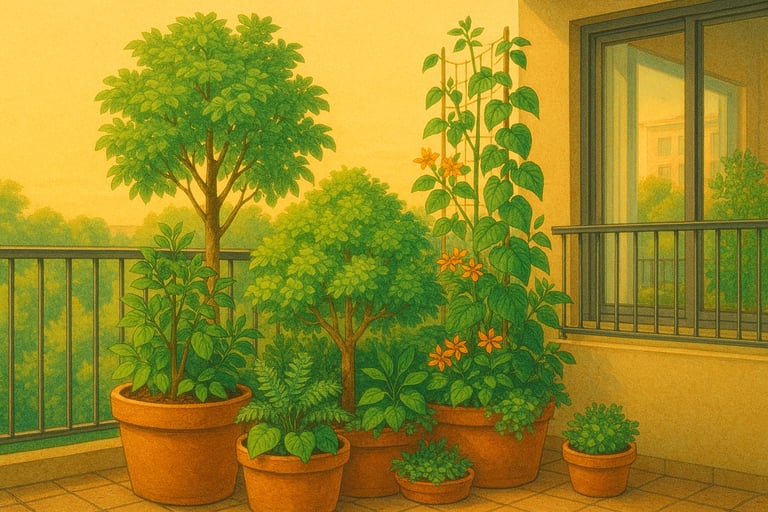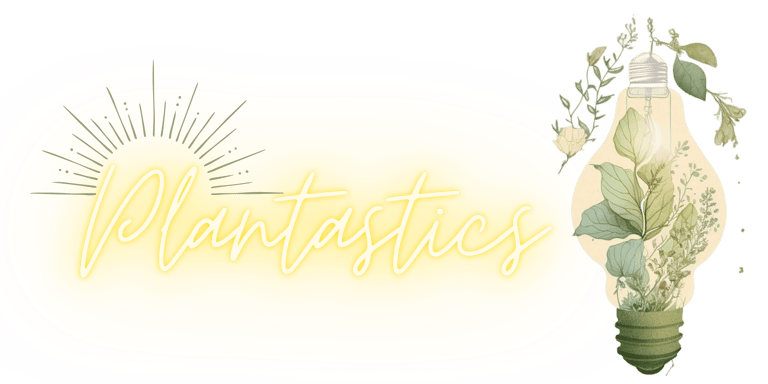Turn Your Balcony into a Mini Forest: 6 Easy Steps to Rewild Your Space
Plantastics


By Savia, your botanical guide and Plantastics Team. Plants have the answer — find out how!
“Close your eyes for a second. Hear that? That soft hum is the bees arriving at your balcony. That fresh breeze… is the shade of your own leaves.” —Savia 🌿
Why a Mini Forest on Your Balcony (the science of coolness and life)
A mini forest is not just “putting pots”: it’s about designing plant layers (canopy, understory, climbers, groundcovers and herbs) that cooperate with each other. What do you gain?
Less heat: more vegetation = less urban heat island effect. Plants transpire and provide shade; green balconies can lower local temperature by 2–4 °C during heatwaves.
Better water management: soil and mulch retain water and reduce runoff.
More biodiversity: staggered blooms attract pollinators; leaves and stems provide habitat for beneficial insects and birds.
Well-being: daily exposure to greenery is linked to reduced stress and better mental health.
Science in 1 Minute: Vegetation = evaporative cooling + shade + humidity boost. Native/adapted plants + structural diversity = more pollinators and resilience.
Before You Start: Observe Your Microclimate
Light: How many hours of direct sun per day? (0–2 shade, 3–4 partial, 5–6+ full sun)
Wind: Are there gusts, corner drafts? (you may need windbreaks or stakes)
Orientation: south and west = hot; north = cool and moist.
Space and weight: measure floor area, railings and max balcony load. Choose lightweight planters (fiber, resin, wood) and avoid overloading.
Water: Easy access? Plan rainwater collection and deep saucers to avoid dripping on neighbors.
Savia’s tip: Take photos at 10 am, 2 pm and 6 pm on a sunny day. Your light tells a different story each hour.
The 6 Steps: From Sketch to Your First Bee
Step 1 — Draw Your Layout (5 min): quick sketch marking sun/shade zones, wind spots, water/electricity points.
Step 2 — Design in Layers: choose 1–2 canopy planters (small tree/shrub), 2–3 climbers, 4–6 herbs/flowers, 2–3 groundcovers. Goal: something in bloom year-round.
Step 3 — Prepare Plant-based Soil Mix (see recipe below): airy, rich, plant-based medium.
Step 4 — Smart Watering: use clay ollas/reservoirs, gravity drip or upside-down bottles + mulching.
Step 5 — Plant by Guilds: group species that support each other (herbs + veggies + pollinator flowers + nitrogen-fixers).
Step 6 — Add Wildlife Shelters: insect hotel, mini pond (bowl with stones), bird perch, and a corner with dead wood (mini nurse log).
Plant Layers (List for Temperate Europe and UK)
Canopy / shrubs in large pots (40–60 L):
Dwarf Japanese maple (Acer palmatum ‘Katsura’/‘Shaina’)
Dwarf pomegranate (Punica granatum ‘Nana’)
Bay laurel (Laurus nobilis)
Compact hazel (if space allows)
Non-invasive bamboo (Fargesia spp.)
Climbers (20–40 L pot + trellis):
Winter jasmine (Jasminum nudiflorum)
Honeysuckle (Lonicera periclymenum)
Small-flower clematis (wind-resistant)
Annual sweet peas (pollinator magnets)
Herbs/flowers (10–20 L):
Lavender, creeping rosemary, thyme, sage
Calendula, cosmos, nasturtium (pollinator-friendly)
Chives, parsley, mint (in separate container)
Compact veggies (15–30 L):
Cherry tomato, sweet pepper, rainbow chard, arugula
Peas/beans on a vertical mesh (N-fixers)
Groundcovers (5–10 L):
Strawberry (Fragaria × ananassa), dwarf white clover, ajuga
Early bulbs: crocus, mini daffodils
Savia’s tip: plan staggered blooming (spring–summer–fall) and add evergreen foliage for winter interest.
(The plants in this section are examples).
Plant based Soil Mix, Smart Watering and Mulching
Plant based Soil Mix (by volume):
40% hydrated coco coir (structure + water retention)
40% mature plant-based compost (no manure)
10% perlite or pumice (aeration)
10% activated biochar (pre-charged with compost tea)
Handful of basalt rock dust (trace minerals)
Optional amendments:
Monthly aerated plant compost tea
Diluted seaweed extract
Watering:
Bury clay olla in large pot, refill 2–3×/week in summer
Upside-down bottle with adjustable dripper for medium pots
Water early morning; avoid wetting foliage in direct sun
Mulch:
Shredded dry leaves, clean straw, wood chips, cocoa husks
3–5 cm layer to reduce evaporation, weeds, and feed soil life
Biodiversity Shelters: Insect Hotel, Water and Flowers
DIY Insect Hotel: hollow stems, twigs, drilled bricks in a wooden frame. Place SE-facing, sheltered from rain.
Mini pond: shallow bowl with stones and exit ramp; refresh weekly.
Nectar-rich flowers: calendula, lavender, hyssop, salvia; avoid overly double hybrids.
No pesticides: let natural predators do the job.
Regenerative Maintenance and 10-Minute Calendar
Mon (10’): check moisture, refill ollas, remove dry leaves.
Wed (10’): pinch back soft growth, check stakes.
Sat (15’): harvest, top-dress with compost, inspect for pests (hand-pick or use soft soap if needed).
Monthly: compost tea, refresh mulch, rotate pots if plants get leggy.
Common Mistakes (and How to Avoid Them)
Tiny pots: stressed roots; choose 20–40 L whenever possible.
Overwatering: black tips and rot; use finger test or moisture meter.
Unprotected wind: install windbreaks (reed screen, polycarbonate) and stakes.
Poor soil: refresh 30% annually, add compost.
Monoculture: mix flowers, herbs, veggies to attract allies.
Measure Your Impact
Temperature: compare wall/floor temperature before & after greening (same day/hour).
Pollinators: count visitors 10 min/week (bees, hoverflies, butterflies) and record species.
Water: track liters per week; mulch + ollas often cut use by 20–30%.
Turn your balcony into a little lab of hope.
Real Balcony FAQ
Only shade (N/NE): ferns, heuchera, ivy, hydrangea, mint, ajuga, strawberry. Flowers: impatiens, begonias.
Very windy: install screens, use heavy pots on perimeter; choose flexible plants (grasses, lavender, rosemary).
Weight/safety: check building’s load limit; spread weight, use light substrates and trays.
Away 2–3 weeks: large ollas + bottles + capillary wicking from upper reservoir.
Download your free Balcony Permaculture Starter Kit (layout templates, material checklist, olla watering guide, plant layer list). Join our newsletter for monthly practical tips and rewilding missions.
https://plantastics.kit.com/newsletter
We design Mini-forests in pots specifically for each balcony or terrace. For more information, contact us here: plantastics@hotmail.com
Plants have the answer. Your balcony can prove it. 💚








